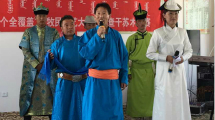Nadam fair
(chinaculture.org)
Updated: 2013-12-18
 |
|
Nadam Fair, meaning 'entertainment,' or 'recreation' in Mongolian, originated in the early days of the 13th century and is a mass traditional Mongolian festival. |
Year:2006
Sort:Folk Custom
Area:Inner Mongolia Serial
No.:Ⅹ-48
Declarer:Xilin Gol League, Inner Mongolia Autonomous Region
Nadam Fair, meaning 'entertainment,' or 'recreation' in Mongolian, originated in the early days of the 13th century and is a mass traditional Mongolian festival. A 'Huli Letai' (big meeting) was held by Mongol leaders every month. Many activities were taken on during the meeting, such as making laws and regulations, appointing and removing officials, giving awards and penalties, and the large Nadam Fair. As recorded, in 1206 when Genghis Khan was elected as the Mongolian Khan, a grand Nadam Fair was held.
Since its birth, the 'three skills' -- wrestling, horse-racing, archery - have been a necessary part of the Nadam activities. In the past, winners of the three sports would be given horses, camels, sheep, brick tea, and silk as prizes.
 |
|
In modern times, more activities have been added, such as polo, horsemanship, track and field, and other ball competitions. |
In modern times, more activities have been added, such as polo, horsemanship, track and field, and other ball competitions. The newly added contents turned the traditional national grand meeting to an auspicious, happy and effective one. Nadam held in Xilin Gol League is the biggest and has become an important activity for the health and entertainment of the masses.
Nowadays, Nadam is always held in summer or autumn (usually July or August) when the grasslands are beautiful and flocks and herds are ready for tallow. It often lasts for three to seven days. During this time, herdsman will come from all over in completely new national costumes, riding their horses, carrying yurt (tent), all kinds of meat and milk products on their light wooden carts. While putting up the yurt, people begin to simmer tea and stew meat.
From ancient times, the 'three skills', wrestling, horse-racing and archery, have been used as standards to judge ability. Such activities can be performed any time and anywhere, since special fields, equipment or a fixed number of people are not necessary. As such the 'three skills' are not only reserved for the festival, but are also performed at events such as weddings and funerals. Many even practice these events in their spare time.
Mongolian wrestling is different from both Chinese wrestling and Japanese sumo wrestling. It is distinguished from other forms by its rules, methods, uniforms and fields. There are no weight or age disticinctions, nor fixed numbers, as long as the numbers are even numbers such as two, four, six, eight, sixteen, thirty-two, sixty-four or one hundred and twenty-eight. All wrestlers are matched by drawing straws or by respected judges. The game uses single- elimination rules in that victory or defeat is determined once. The loser is not allowed to compete again. Half of the contestants will be eliminated each time. As soon as the judge gives an order to start, the opponents first shake hands to show respect to each other, and then begin to wrestle. There is no time limitation and the opponents can tick, pull, kick, trip, push and hold. However, one not allowed to wrestle while holding the other's legs, kick arbitrarily, or pull the other's trousers. The person who touches the ground with any part of the body above the knees is the loser.

